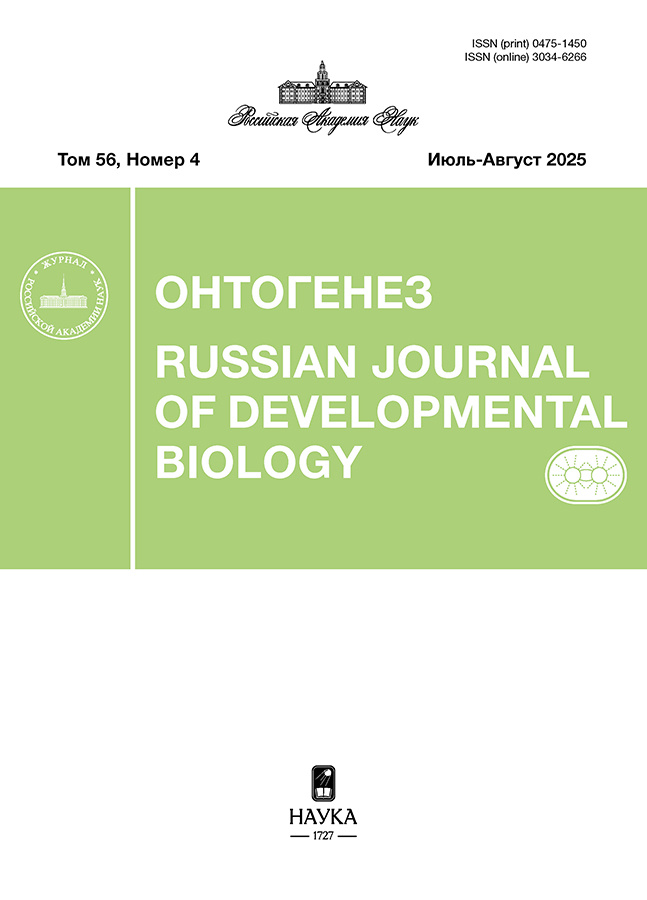Онтогенез
ISSN (print): 0475-1450
Свидетельство о регистрации СМИ: ПИ № ФС 77 - 66702 от 28.07.2016
Учредитель: Российская Академия наук
Главный редактор: Васильев Андрей Валентинович
Число выпусков в год: 6
Индексация: РИНЦ, перечень ВАК, Ядро РИНЦ, RSCI, CrossRef, Белый список (3 уровень)
Журнал «Онтогенез» - научное издание, специализирующееся в области биологии развития и смежных дисциплин.
Журнал публикует экспериментальные, теоретические и обзорные статьи, посвященные исследованию механизмов индивидуального развития, дифференцировки и роста. Особое внимание уделяется исследованиям механизмов эмбрионального и постэмбрионального развития в норме и при патологии, выполненным на молекулярном, клеточном, тканевом и организменном уровнях.
Журнал выходит 6 раз в год на русском и английском языках. Название английской версии "Russian Journal of Developmental Biology".
Журнал издается под руководством Отделения биологических наук РАН.
Журнал является рецензируемым, включен в Перечень ВАК.
Статьи, публикуемые в журнале, индексируются в следующих базах данных: РИНЦ, Web of Science, Science Citation Index Expanded (SciSearch), Chemical Abstracts Service (CAS), Google Scholar, EBSCO, CSA, Academic OneFile, AGRICOLA, Biological Abstracts, BIOSIS, Current Abstracts, EMBiology Gale, INIS Atomindex, Journal Citation Reports/Science Edition, OCLC, Summon by Serial Solutions, Zoological Record, PubMed (as "Ontogenez").
Текущий выпуск
Том 56, № 4 (2025)
ОБЗОРЫ
Что можно узнать о регуляции развития цветка, изучая его спонтанную изменчивость
Аннотация
Закономерности развития цветка могут быть изучены при анализе его спонтанной изменчивости, наблюдаемой не только на внутривидовом уровне, но и в пределах одного растительного организма. При круговом расположении органов их число в круге (мерность) может быть нестабильным из-за колебаний размеров флоральной меристемы или варьирования в скорости ее пролиферации. К источникам меристических флуктуаций относится архитектура соцветия: цветки различного строения могут встречаться на осях разного порядка, меньшая стабильность характерна для истинно верхушечного цветка. Неодинакова устойчивость абаксиального и адаксиального доменов цветка. Например, в зигоморфном венчике бобовых наиболее стабилен адаксиальный лепесток, что хорошо согласуется с его эволюционной консервативностью в этом семействе. Более высокая по сравнению с другими кругами цветка изменчивость андроцея предположительно подчиняется общебиологической закономерности – повышению вариабельности структур, формирующихся в развитии позже. Корреляции между числами органов в разных кругах цветка могут быть использованы для определения характера его разметки. В одних таксонах каждый круг размечается под влиянием более проксимального круга (акропетальная разметка). В цветках других групп положение тычинок связано с гинецеем (базипетальная разметка андроцея). Также возможна разметка внутреннего круга андроцея под влиянием гинецея, а наружного под действием околоцветника. При спонтанных колебаниях строения цветка между мерностями кругов, связанных в ходе разметки, наблюдается более высокая корреляция.
 131-142
131-142


ОРИГИНАЛЬНЫЕ ИССЛЕДОВАНИЯ
Особенности латентного и прегенеративного периодов развития видов рода DIANTHUS L. в условиях башкирского предуралья
Аннотация
Описаны начальные этапы онтогенеза видов родаDianthusL. (гвоздика):D. barbatusL.,D. carthusianorumL.,D. giganteusd’Urv,D. hypanicusAndrz.,D. knappii(Pant.) Asch. & Kanitz ex Borbas,D.oschtenicusGalushko,D. plumariusL. Исследования проводили в условиях континентального климата Башкирского Предуралья, на базе Южно-Уральского ботанического сада-институтаУфимского федерального центра Российской академии наук (ЮУБСИ УФИЦ РАН). В ходе исследований были решены следующие задачи: описаны два возрастных периода–латентный, прегенеративный и 4 возрастных состояния (проростки, ювенильное, имматурноеи виргинильное); описаны признаки, характерные для каждого состояния; охарактеризованы морфологическиепараметры растений; выявлены особенности развития изученных видов на начальных периодахонтогенеза. Выделены маркерные признаки прегенеративных онтогенетических состояний гвоздики (проростки, ювенильные,имматурные, виргинильные растения), указана продолжительность пребывания в каждом из них.
 143-151
143-151


КРАТКИЕ СООБЩЕНИЯ
Первые сведения о развитии перибластического синуса в эмбриогенезе азиатской корюшки Osmerus dentex (Osmeridae)
Аннотация
Проведено экспериментальное исследование эмбрионального развития азиатской зубастой корюшкиOsmerus dentexSteindachner etKner, 1870, обитающей в реке Тауй (Тауйская губа северной частиОхотского моря). Впервые как для данного вида, так и дляпредставителей родаOsmerusобнаружена стадия перибластического синуса–провизорного органа,развитие которого (как и у многих представителей Salmoniformes) начинается в конце этапа гаструляции и эпиболии и завершается на этапе органогенеза.
 152-156
152-156












